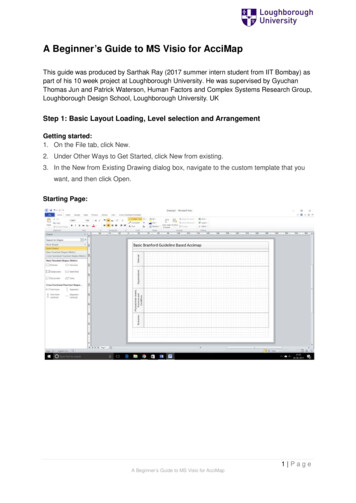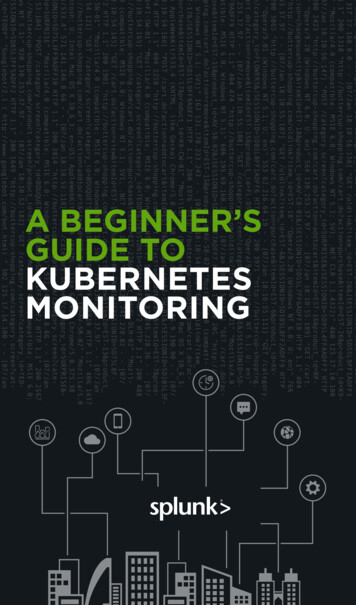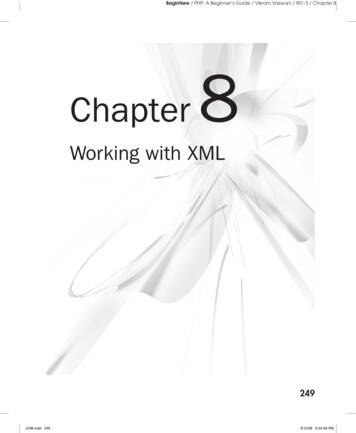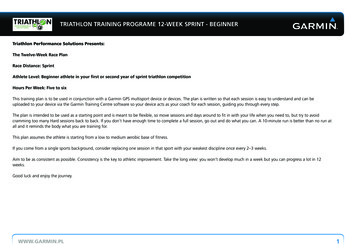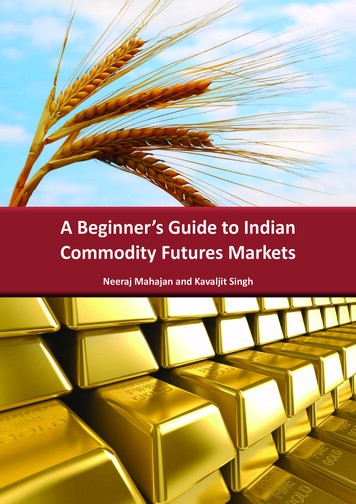
Transcription
A Beginner’s Guide to IndianCommodity Futures MarketsNeeraj Mahajan and Kavaljit Singh
A BEGINNER’S GUIDE TO INDIANCOMMODITY FUTURES MARKETSNEERAJ MAHAJAN AND KAVALJIT SINGHMADHYAM
Madhyam is a non-profit policy research institute based in New Delhi, India.Kavaljit Singh is Director of Madhyam.Neeraj Mahajan is an independent journalist based in New Delhi.Published in 2015 by:Madhyam148, Maitri ApartmentsPlot No.28, PatparganjNew Delhi: 110092, IndiaPhone: 91-11-43036919Email: madhyamdelhi@gmail.comWebsite: www.madhyam.org.inCreative Commons Attribution Non Commercial No Derivatives 3.0Since this publication is meant for nonprofit, research and educational purposes, you are welcome to reproduce it provided thesource is acknowledged. We will appreciate if a copy of reproduced materials is sent to us.Designed by KS Designers, New Delhi.
CONTENTSAcronymsixData NotesxAcknowledgementsxiIntroductionxiiiHow This Guide is OrganizedxvPART I1.Understanding Commodities3What is a commodity?Which kinds of commodities are traded in the world?Why are commodities important?What are the main differences between commodity spot and derivatives markets?Why are prices in global commodities markets volatile?2.Understanding Derivatives and Commodity Futures Trading7What is a derivative contract?What are exchange-traded derivatives?What are over-the-counter (OTC) derivatives?Why are derivatives considered a double-edged sword?What are the key functions of commodity futures trading?Which commodities are suitable for futures trading?What is an “underlying” and how is it different from a “contract”?What is convergence?3.Understanding Commodity Derivatives Exchanges17What is a commodity derivatives exchange?What were the historical reasons behind setting up commodity exchanges worldwide?How does a commodity derivatives exchange function?What is the role of an exchange in futures trading?How are futures prices on the exchange determined?Which are the biggest global commodity derivatives trading exchanges?4.The Market ParticipantsWho are the main players in commodity futures market?Why is farmer participation in the Indian commodity futures markets very low?23
Are foreign investors allowed to trade in the Indian commodity markets?Are banks and financial institutions allowed to trade in commodity futures markets in India?5.The Financialization of Commodities27What is financialization of commodities?Why are financial players interested in commodity derivatives?What has been the impact of financial players?6.A World Full of Manipulated Markets33Silver Thursday and the Hunt Brothers ScandalCrude Oil Price Fixing ScandalThe Enron ScandalThe Copper King ScandalPART II7.Commodity Futures Markets in India39Are commodity derivatives new in India?What was the rationale behind setting up commodity futures exchanges in India?What are the major commodity exchanges in India?What is the status of regional commodity exchanges?Which commodities are allowed in the Indian futures markets?Are options allowed in commodity derivatives trading in India?Are deliveries compulsory in Indian commodity futures markets?What is staggered delivery?8.How are the Indian Commodity Futures Markets Manipulated?45What are the common fraudulent business practices?What is circular trading? How does it contribute to market manipulation?What is open interest and what does it reveal?What are the international best practices on open interest?How does profit and loss accounting in commodity futures trading lead to tax evasion?What is dabba trading?What is wash trading?What is client code modification (CCM) and how is it used to evade taxes?9.The Guar Futures Trading Scandal49What is guar?What led to steep rise in guar futures prices?How were the guar futures prices manipulated?Did guar farmers benefit from the steep hike in prices?What was the regulatory response to the guar trading scandal?( vi )
10. The NSEL Payment Scam53How did the NSEL payment scam unfold?What was the modus operandi?What was the regulatory response?What happened to the settlement guarantee fund?How were warehouse receipts forged?Is weak regulatory framework responsible for the NSEL scam?11. The Regulatory Issues in India59Why should commodity futures markets be regulated?Who regulates the commodity futures markets in India?What are the key regulatory tools used by FMC in the recent past?What are the key regulatory and governance gaps in Indian commodity futures markets?Should FMC be given more powers and greater administrative autonomy?Should FMC encourage independent research for evidence-based policymaking?12. The Commodity Transaction Tax63What is a commodity transaction tax?What are the main benefits of CTT?Can CTT trigger a sharp fall in futures trading?Is CTT a panacea?PART III13. Policy Issues and Challenges67Is speculation good for commodity futures markets?Why is there so much excessive speculation in the Indian futures markets? Are futures markets performing the two important functions of price discoveryand price risk management in India? What policy reforms are needed to encourage the participation of farmersand commercial hedgers?To what extent should algorithmic trading be allowed in commodity futures markets?Should banks be allowed to trade in commodity futures markets in India?Do futures markets aggravate rise in commodity prices?What should be the government’s policy towards regional commodity exchanges?Should large companies disclose their positions in commodity futures markets?Should India implement international regulatory reforms initiated by the G20?Glossary83Useful Links91( vii )
LIST OF BOXESBox 1 : Commodity Physical Forward Contracts8Box 2 : Exotic Derivatives Trap Small Exporters in India14-15Box 3 : U S Senate report: Banks Had “Unfair Advantage” in Physical Commodities Business30-32Box 4 : NSEL Debacle has Damaged the Prospects of Fungibility of Warehouse Receipts75-76LIST OF TABLESTable 1 : Billion-Dollar Losses in Commodity Derivatives Deals10Table 2 : Top 15 Derivatives Exchanges Worldwide20Table 3 : Top 12 Most Active Banks in Commodities Derivatives27Table 4 : Group-wise and Commodity-wise trading in the Indian Futures Market42Table 5 : Futures Trade Multiples of Various Agricultural Commodities68( viii )
ACRONYMSBISBank for International SettlementsCDSCredit Default SwapCFTCCommodity Futures Trading CommissionCMEChicago Mercantile ExchangeCTTCommodity Transaction TaxFIIForeign Institutional InvestorFMCForward Markets CommissionGDPGross Domestic ProductICEIntercontinental Exchange Inc.ICEXIndian Commodity ExchangeIFFCOIndian Farmers Fertilizer Cooperative LimitedIOSCOInternational Organization of Securities CommissionsISINInternational Securities Identification NumberMCAMinistry of Corporate AffairsMCXMulti Commodity Exchange of IndiaNAFEDNational Agricultural Co-operative Marketing Federation of India LimitedNBOTNational Board of TradeNCDEXNational Commodity and Derivatives Exchange of IndiaNMCENational Multi Commodity ExchangeNYMEXNew York Mercantile ExchangeOCEILOnline Commodity Exchange India LimitedOTC Over-the-counterPDSPermanent Account NumberPDSPublic Distribution SystemRBIReserve Bank of IndiaSEBISecurities and Exchange Board of IndiaSGFSettlement Guarantee FundUCCUnique Client CodeUNCTADUnited Nations Conference on Trade and Development( ix )
DATA NOTES1 US Rs.62 (as of March 2015)Dollars are US dollars unless otherwise specified1 Rs.70 (as of March 2015)1 lakh is 100,0001 crore is 100 lakh (or 10 million)1 million is 10,00,000 (10 lakh)1 billion is 1,000 million1 trillion is 1,000 billion1 quintal is 100 kilogram, or Kg1 tonne is 1,000 kg(x)
ACKNOWLEDGEMENTSWe express our thanks to all those individuals and organizations who provided support in the research and publicationof the Guide. In particular, we would like to thank Tarun Soni for his immense contribution in the early stages of researchand the glossary section. We are thankful to Myriam Vander Stichele (Senior Researcher, SOMO, Amsterdam),G. Chandrashekhar (Commodities Editor, The Hindu Businessline, Mumbai), Dilip Kumar Jha (Commodities Editor, BusinessStandard, Mumbai), and Dr. R. Sendhil (Scientist, Directorate of Wheat Research, Karnal) for providing valuable inputsand comments on the draft manuscript besides sharing a number of articles, documents and books with us. Specialthanks to Kaveri Nandan for copy editing the manuscript. Thanks are also due to all those experts whose writings anddata we have drawn upon in the preparation of the Guide. However, the authors remain responsible for any errors.( xi )
( xii )
INTRODUCTIONWhen food prices rose dramatically worldwide during the 2007-2008 period, food riots broke out in many poorcountries and there were fears of high price volatility and inflation in the developed countries. The food price spikecreated a global food crisis. Concerns over the social unrest and economic instability compelled the policymakersto examine the factors behind the worldwide increases in food prices. Apart from analyzing developments in thespot markets, the policymakers also turned their attention to the commodity derivatives markets, which had beenundergoing major changes since 2000. In India, too, the role of futures trading in aggravating the price hike washotly debated when the government banned futures trading in several agricultural commodities in 2008 to controlfood inflation.Commodity trading in food and other agricultural products, metals and energy products is not a new phenomenon.It is probably one of the most ancient economic activities and, therefore, it would not be incorrect to state that commodity trading is as old as human civilization. Over the centuries, commodity trading has undergone tremendouschanges, from the barter system to spot markets to futures markets.In the past few decades, trading in commodity futures has also evolved from “open-outcry” methods (which involved trading through a combination of hand signals and verbal orders in trading pits) to computer-poweredelectronic trading. Nowadays, big traders use sophisticated tools such as algorithmic trading (which involves nohuman intervention) for trading in commodity futures, and individuals often use mobile phones for placing orders.As a result, trading in commodity futures around the globe has now become more sophisticated, convenient andquicker than in the past.Even though organized commodity derivatives in India began in the 19th century, commodity futures markets haveflourished in recent years with the onset of reforms to liberalize the economy in the 1990s. The major steps towardsintroduction of futures trading in commodities were initiated in 2004 with the removal of prohibition on futures trading in all recommended commodities and the setting up of commodity exchanges at the national level. Since then,the commodity futures markets have witnessed a rapid increase in trading volumes, market participation and thenumber of commodities traded. The commodity futures were initially permitted to trade in agricultural products butnowadays bullion, metals and energy products dominate the trading volume.India and other developing countries such as China, Brazil and South Africa have important commodity derivativesmarkets. The monthly turnover in Indian commodity exchanges is next only to the US and China. However, despiterapid growth in trading volume, the commodity futures markets have frequently courted controversy in India dueto numerous factors, including pervasive market abuses and manipulation that have badly affected market integrity,weakened integration of spot and futures markets, raised concerns over price rise, and poor regulation and supervision.How can citizens, farmers, parliamentarians, market practitioners, policy makers, academicians and journalists beinvolved in ensuring that commodity derivatives markets function properly in a fair and orderly manner and whereeffective regulations are in place and enforced by regulators to maintain market integrity? It is the duty of regulatoryauthorities to curb rampant manipulation and other unfair trading practices. In the aftermath of the 2008 globalfinancial crisis, some regulatory reforms have been initiated in the US, European Union (EU) and some other countries to enhance market transparency and coordination among regulatory authorities. But a lot still needs to be doneto ensure appropriate market surveillance and enforcement at both national and international levels.This Guide is prepared with an aim to engage citizens, farmers, parliamentarians, market practitioners, policy makers, academicians and students with interest in the area of commodity derivatives markets in general and Indianmarkets in particular. The Guide explains basic concepts and workings of the commodity derivatives markets,raises several policy concerns and provides specific policy recommendations to improve the regulation and supervision of markets in the public interest.( xiii )
There is no denying that there are several easy-to-read publications and beginner’s guides (available in print andonline) that explain the workings of commodity futures markets in India. But most, if not all, have been brought outby brokerage houses and commodity exchanges to encourage people to invest in these markets. In such publications, several important matters related to the functioning of futures markets such as market abusive practices,scams and regulatory loopholes are not discussed at length as doing so may deter potential investors.In this regard, A Beginner’s Guide to Indian Commodity Futures Markets is a departure from commercial publications as it aims to raise critical policy issues related to the functioning, structure, regulation and governance ofcommodity futures markets in India. Written from a public interest perspective, this publication attempts to describecomplex and technical terms in a simple language and style. We have also questioned some stylized facts aboutfutures markets.We humbly accept that this publication does not address several vital policy issues related to futures markets thatare fiercely debated in India and around the world. We hope that other researchers and analysts would addressthose. It is likely that this publication may provoke additional questions in the minds of readers. We look forward toyour questions, comments and suggestions.– Neeraj Mahajan and Kavaljit Singh( xiv )
HOW THIS GUIDE IS ORGANIZEDThe Guide is organized into three parts:Part I explains the basics of commodity futures markets in a historical and theoretical context. It providesa basic understanding of concepts and terminology related to commodities, derivatives, commodity futurestrading, commodity exchanges and market participants. The financialization of commodities and its implications are critically examined in this section besides discussion of some of the important scandals in the globalcommodity markets.Part II specifically deals with issues and concerns related to the Indian commodity futures markets. It examines the policy environment that has shaped the rise of Indian commodity futures markets in the recent times.In particular, instances of frequent manipulation and some recent trading scandals in the Indian commodityfutures markets are discussed at length. This section also explores the efficacy of commodity transactiontax and provides policy recommendations to strengthen the regulation and supervision of Indian commodityfutures markets.Part III focuses on key policy issues and challenges faced by commodity futures markets. By citing examplesfrom the Indian markets, it questions the role of excessive speculation, algorithmic trading and other practicesthat tend to undermine the usefulness and efficiency of a commodity futures market. Some of the recentpolicy initiatives and regulatory reforms are also discussed in this section.( xv )
( xvi )
PART IChapter 1 explains the various types of commodities and the role played by them in the economic development ofcountries. It delineates key differences between spot and derivatives markets, and discusses the risks of excessivecommodity price volatility, which has significant implications on all countries.Chapter 2 defines derivatives, and their various types. It describes how mega corporate houses, investment banksand traders have failed to comprehend the true risks associated with derivative trading and ended up suffering hugelosses while trying to profit from predicting future events. With the help of examples, this chapter explains in detailthe key economic functions of commodity futures trading.Chapter 3 provides a brief history of commodity futures exchanges. It explains how exchanges function in thepresent world and how prices are determined on a futures exchange.Chapter 4 describes the key market participants and the different roles that they play in the commodity futuresmarkets. The chapter critically examines the reasons behind the low participation of Indian farmers in the commodity futures market and discusses the current status regarding the entry of banks and financial institutions in theIndian commodity futures markets.Chapter 5 examines the entry of financial players (such as investment banks and hedge funds) in the global commodity derivatives markets. It critically analyzes the potential implications of futures trading by financial players onprice formation.Chapter 6 discusses how big market players and financial speculators have skewed the markets through pricemanipulation in both futures and spot markets. The chapter showcases four major scandals caused by manipulative trading practices in the global commodity markets.
(2)
1. UNDERSTANDINGCOMMODITIESWhat is a commodity?Commodities are products that can be bought, sold or traded in different kindsof markets. Commodities are the raw materials that are used to create productswhich are consumed in everyday life around the world, from food products inIndia to building new homes in Europe or to running cars in the US.There are two main types of commodities: Soft commodities – agricultural products such as corn, wheat, coffee,cocoa, sugar and soybean; and livestock. Hard commodities – natural resources that need to be mined or processed such as crude oil, gold, silver and rubber.Throughout history, commodities have played a major role in shaping the globalpolitical economy and have affected the lives and livelihoods of people. Historyis replete with examples of how shortage of critical commodities sparked hugepublic outcry and social unrest. Of late, the world community is concerned overthe environmental and health costs of production and consumption of certaincommodities and impact on society.Which kinds of commodities are traded in the world?In the global markets, there are four categories of commodities in which tradingtakes place: Energy (e.g., crude oil, heating oil, natural gas and gasoline). Metals (e.g., precious metals such as gold, silver, platinum and palladium; base metals such as aluminium, copper, lead, nickel, tin andzinc; and industrial metals such as steel). Livestock and meat (e.g., lean hogs, pork bellies, live cattle and feedercattle). Agricultural (e.g., corn, soybean, wheat, rice, cocoa, coffee, cottonand sugar).Commodities are products that canbe bought, sold or traded in different kinds of markets. Commoditiesare the raw materials that are usedto create products which are consumed in everyday life around theworld, from food products in Indiato building new homes in Europe orto running cars in the US.Why are commodities important?Commodities play an important role in the economic development of all countries – developed, developing and least developed countries (LDCs). In the caseof LDCs, numbering 48 at present, more than two-thirds of the labour forceis dependent on agriculture. In India, too, over 60 percent of the population isdependent on agriculture for livelihood.According to UNCTAD statistics, 27 LDCs are commodity exporters. In fact,commodities accounted for almost 80 percent of LDCs’ goods export during2007-09. Given the LDCs’ heavy dependence of commodities, any developmentMadhyam A Beginner’s Guide to Indian Commodity Futures Markets3
strategy aimed at economic growth, poverty reduction and food security needsto recognize the crucial role played by commodities and natural resources inthese economies. As witnessed during the recent triple crises – food, financialand fuel – the economies of LDCs remain vulnerable due to their over-relianceon few primary commodities, and price volatility.What are the main differences between commodity spot andderivatives markets?There are two types of commodity markets: spot (physical) and derivatives(such as futures, options and swaps).In a spot market, a physical commodity is sold or bought at a price negotiatedbetween the buyer and the seller. The spot market involves buying and sellingof commodities in cash with immediate delivery. There are spot markets forindividual consumers (retail market) and the business-to-business (wholesalemarket) category. Spot markets also include traditional markets such as Delhi’sAzadpur Mandi that deal in fruits and vegetables.A futures contract is a pre-determined and standardized contractto buy or sell commodities for aparticular price and for a certaindate in the future.On the other hand, a commodity can be sold or bought via derivatives contractas well. A futures contract is a pre-determined and standardized contract to buyor sell commodities for a particular price and for a certain date in the future. Forinstance, if one wants to buy 10 tonne of rice today, one can buy it in the spotmarket. But if one wants to buy or sell 10 tonne of rice at a future date, (say,after two months), one can buy or sell rice futures contracts at a commodityfutures exchange.The futures contracts provide for the delivery or receipt of a physical commodityof a specified amount at some future date. Under the physically settled contract, the full purchase price is paid by the buyer and the actual commodity isdelivered by the seller. But in a futures contract, actual delivery takes place later.For instance, a farmer enters into a futures contract to sell 10 tonne of rice at 100 per tonne to a miller on a future date. On that date, the miller will pay thefull purchase price ( 1,000) to the farmer and in exchange will receive the 10tonne of rice.Delhi’s Azadpur market is one of the biggest spotmarkets dealing in fruits and vegetables in India.4Madhyam A Beginner’s Guide to Indian Commodity Futures Markets
However, under the cash-settled futures contract, the farmer and the millerwould simply exchange the difference between the spot price of rice on thesettlement date and the agreed upon price as mentioned in the futures contractand there would be no actual delivery of rice. Following the above example, if onthe settlement date the price of rice was 80 per tonne, while the agreed uponprice of futures contract was 100 a tonne, the miller will pay 200 to the farmerin cash and there will be no delivery of rice to the miller. If, on the settlementdate, the price of rice was 120 a tonne, the farmer will pay 200 to the millerin cash and no delivery of rice will take place.In practice, most futures contracts do not involve delivery of physical commodity as contracts are settled in cash through an exchange. The financial investorsprefer cash settlement because of no interest in buying or selling the underlying commodity, and lower transaction costs. Nowadays, the entire process offutures trading in commodities is carried out electronically throughout the world.Why are prices in global commodities markets volatile?The sharp upward or downward movement in prices (in other words, price volatility) is one of the key problems associated with commodities. Price volatilitycan result from irregular production and harvests as well as from swings indemand and supply. Volatility evokes risks for both producers and consumers.Volatile prices can have a devastating impact on economies. For instance, ifhigher prices for imported oil continue for a prolonged period of time, it cangenerate serious payments problems, as was witnessed in India during the1990-91 period. On the other hand, lower prices can lead to less income forcommodity exporting countries.A sharp increase in global food and fuel prices during 2007-08 resulted in foodriots in many developing countries. It also contributed to a worsening of thetrade balance and current account deficits in many oil-importing and foodimporting developing countries. It posed new challenges for reducing poverty,preserving food security, controlling inflation and maintaining macroeconomicstability. This prompted policy makers to put the issues of commodity pricevolatility and the price formation on commodity derivatives markets high on theglobal policy and financial reform agenda.Most futures contracts do notinvolve delivery of physical commodity as contracts are settled incash through an exchange.As discussed later in this Guide, a combination of domestic and internationalfactors drives prices in global commodity markets. There is no denying thatthe rapid growth in production and consumption of China and India has contributed to a massive surge in demand for commodities from energy to minerals in recent years. In addition, intense speculative activity by financial players,geo-political factors and tight supply capacities have also significantly affectedcommodity prices and volatility.Madhyam A Beginner’s Guide to Indian Commodity Futures Markets5
6Madhyam A Beginner’s Guide to Indian Commodity Futures Markets
2. UNDERSTANDING DERIVATIVESAND COMMODITIES FUTURESTRADINGWhat is a derivative contract?A derivative contract is an enforceable agreement between two parties wherethe value of the contract is based or derived from the value of an underlying asset. The underlying asset can be a commodity, stock, precious metal, currency,bond, interest rate, index, etc.Some of the widely used derivative contracts are as following:Forwards: A forward contract is a non-standardized or customized contract between two parties to undertake an exchange of the underlying asset at a specificfuture date at a pre-determined price. It is a bilateral agreement whose termsare negotiated and agreed upon between two parties. It is transacted over-thecounter and is not traded on an exchange. The contract is executed by both parties on the due date by delivery of asset by the seller and payment by the buyer.Futures: Commodity futures contracts are agreements made on a futures exchange to buy or sell a commodity at a pre-determined price in the future.The futures contracts are traded on regulated exchanges and the terms of thecontract are standardized by the exchange. What is negotiated by the counterparties (buyer and seller of a futures contract) is only the price. The price isdiscovered through the offers and bids process. As explained in the previouschapter, all contracts are settled by cash or physical delivery of the underlyingcommodity on the expiry date of the contract. In Indian exchanges, almost allcommodity futures contracts are cash-settled.Commodity futures contracts areagreements made on a futuresexchange to buy or sell acommodity at a pre-determinedprice in the future.Options: Commodity options are contracts that give the owner the right, butnot the obligation, to buy or sell an agreed amount of a commodity on or beforea specified future date.Swaps: A commodity swap is an agreement between two parties to exchangecash (flows) on or before a specified future date based on the underlying valueof commodity, currency, stock or other assets. Unlike futures, swaps are notexchange-traded instruments. Swaps are usually designed by banks and financial institutions that also arrange the trading of these bilateral contracts.What are exchange-traded derivatives?Broadly speaking, there are two groups of derivative contracts – exchangetraded and over-the-counter (OTC) – based on the manner in which they aretraded in the market.Exchange-traded derivatives are those instruments (such as futures and options) that are traded on derivatives exchanges. The last decade has witnessedtremendous growth in this segment.In terms of number of traded contracts, the commodity derivative markets haveMadhyam A Beginner’s Guide to Indian Commodity Futures Markets7
Box 1Commodity Physical Forward ContractsIn many countries, billions of dollars worth of commodities are traded dailythrough forward contracts providing for physical delivery. A forward contract is an agreement between the seller and the buyer for the delivery ofa certain quality and quantity of a commodity at a specific future date andfor a specified price. Such contracts are independent, bilaterally negotiated,private contracts and therefore not conducted at an organized exchange.Nevertheless, such contracts are legally binding.Nowadays most commodity physical forwards are conducted on electronictrading platforms. Since these contracts are conducted in physical forwardmarkets, they bring together the commodity producer, merchandiser andconsumer at a common marketplace. The commodity physical forwardmarkets necessitate substantial investments in the logistical infrastructure(transportation and storage facilities) for the physical delivery of the underlying commodity. It involves building and managing the logistics of the supplychain from producers to consumers.The commodity physical forwards are different from commodity futures contracts in many important ways. Unlike futures, the majority of commodityphysical forwards result in the physical delivery of the underlying commodity.Only in exceptional circumstances, such contracts could be fully or partiallycash settled. The transfer of ownership of the underlying physical commodityis an important functio
Over the centuries, commodity trading has undergone tremendous changes, from the barter system to spot markets to futures markets. In the past few decades, trading in commodity futures has also evolved from "open-outcry" methods (which in-volved trading through a combination of hand signals and verbal orders in trading pits) to computer-powered
